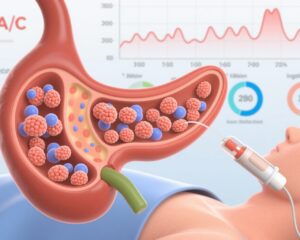Highlight
This clinical trial demonstrated that both dapagliflozin and exenatide monotherapy significantly improve beta-cell function (BCF) and insulin sensitivity in patients with type 2 diabetes. Combination therapy with dapagliflozin plus exenatide resulted in markedly greater enhancements in these parameters than either agent alone. The improvements were sustained over four months, supporting the synergistic efficacy of SGLT2 inhibitors with GLP-1 receptor agonists in diabetes management.
Study Background and Disease Burden
Type 2 diabetes mellitus (T2DM) is characterized by insulin resistance and progressive beta-cell dysfunction resulting in chronic hyperglycemia and multisystem complications. Despite various pharmacological agents, optimal preservation and improvement of beta-cell function remain critical unmet needs in diabetes care to delay disease progression and reduce complications.
Recent advances highlight the complementary roles of sodium-glucose cotransporter 2 inhibitors (SGLT2is) and glucagon-like peptide-1 receptor agonists (GLP-1RAs) not only improving glycemic control but also potentially modulating beta-cell health and insulin sensitivity. Dapagliflozin, an SGLT2 inhibitor, reduces renal glucose reabsorption to decrease hyperglycemia and may relieve glucotoxicity affecting beta cells.
Exenatide, a GLP-1RA, enhances glucose-dependent insulin secretion, delays gastric emptying, and may exert direct trophic effects on beta cells. Understanding how these agents individually and synergistically affect beta-cell function and insulin sensitivity is crucial for advancing therapeutic strategies in T2DM.
Study Design
This was a randomized, controlled clinical trial enrolling ninety patients with type 2 diabetes. Patients were assigned to one of four groups: placebo (n=15), dapagliflozin monotherapy (n=25), exenatide monotherapy (n=25), or combination therapy with dapagliflozin and exenatide (n=25).
The study evaluated acute effects following a single drug dose and chronic effects at one and four months of therapy. A 180-minute oral glucose tolerance test (OGTT) was conducted at these time points to assess glucose metabolism, insulin secretion, and beta-cell function.
The corrected Matsuda index (cMI) was utilized to estimate insulin sensitivity accounting for urinary glucose loss induced by SGLT2 inhibition. Insulin secretion and beta-cell function indices were calculated from OGTT data to quantify functional pancreatic responses.
Key Findings
The acute administration of dapagliflozin, exenatide, and their combination significantly increased insulin sensitivity (cMI) compared to placebo. Mean cMI increased from 1.63 ± 0.36 in placebo to 2.29 ± 0.33 with dapagliflozin, 2.03 ± 0.12 with exenatide, and 2.36 ± 0.14 with combination therapy (P < 0.05).
At one and four months, exenatide’s improvement in insulin sensitivity remained stable, while dapagliflozin and the combination therapy exhibited further significant increases (P < 0.001), indicating sustained and enhanced effects over time.
Regarding insulin secretion, dapagliflozin alone did not significantly raise secretion compared to placebo in the acute setting, whereas exenatide and the combination therapy markedly increased insulin release (P < 0.001 vs. dapagliflozin). This augmented secretion with exenatide-containing regimens persisted at both follow-up time points.
Crucially, the beta-cell function (BCF) index showed pronounced improvements. Compared with placebo (0.40 ± 0.04), dapagliflozin monotherapy raised BCF by 62% (0.65 ± 0.10, P < 0.05), exenatide tripled it (1.17 ± 0.22, P < 0.001), and combination therapy quadrupled BCF (1.69 ± 0.12, P < 0.001). While dapagliflozin and exenatide monotherapies further improved BCF at 1 and 4 months, combination therapy BCF plateaued, suggesting an early maximized synergistic effect.
No safety concerns or adverse events related to the interventions were reported in the study, consistent with the established safety profiles of dapagliflozin and exenatide.
| Parameter | Placebo | Dapagliflozin | Exenatide | Dapagliflozin/Exenatide |
|---|---|---|---|---|
| Acute cMI (Mean ± SEM) | 1.63 ± 0.36 | 2.29 ± 0.33* | 2.03 ± 0.12* | 2.36 ± 0.14* |
| BCF Index (Acute) | 0.40 ± 0.04 | 0.65 ± 0.10† | 1.17 ± 0.22‡ | 1.69 ± 0.12‡ |
| Insulin Secretion (Acute) | Baseline | Similar to placebo | Higher vs. dapagliflozin§ | Higher vs. dapagliflozin§ |
| BCF Index (1 & 4 months) | Stable | Increased further | Increased further | No further increase |
*P < 0.05 versus placebo; †P < 0.05 versus placebo; ‡P < 0.001 versus placebo; §P < 0.001 versus dapagliflozin
Expert Commentary
This study adds compelling evidence to support dual therapy with SGLT2 inhibitors and GLP-1 receptor agonists in T2DM by demonstrating superior enhancement of beta-cell function and insulin sensitivity compared to monotherapy. Improved insulin sensitivity likely results from reduced glucotoxicity and renal glucose loss with dapagliflozin, while exenatide potentiates glucose-dependent insulin secretion and may exert direct beta-cell preservation.
The synergistic augmentation seen with combination therapy suggests potentially improved long-term glycemic durability and metabolic benefits. However, the plateau in beta-cell function at 4 months indicates a ceiling effect, warranting further investigation into long-term sustainability and whether adjunctive treatments or lifestyle interventions could augment this further.
Limitations include relatively short duration, modest sample size, and lack of direct beta-cell mass measurements. Future studies should explore impacts on disease progression, cardiovascular outcomes, and patient-centered endpoints.
Conclusion
The combination of dapagliflozin and exenatide offers a compelling therapeutic strategy in type 2 diabetes management by markedly improving beta-cell function and insulin sensitivity beyond either agent alone. These findings emphasize the clinical benefits of combination therapy targeting complementary pathophysiological pathways in T2DM. Sustained enhancement of pancreatic beta-cell responsiveness and systemic insulin sensitivity may translate to improved glycemic control and disease modification. Further large-scale, long-term studies are needed to confirm durability and effects on diabetes complications.
References
1. Triplitt C, et al. Changes in beta-Cell Function and Insulin Sensitivity During Treatment With Dapagliflozin Alone or in Combination With Exenatide in Type 2 Diabetes. Diabetes Care. 2025 Sep;48(9):1545-1552. doi:10.2337/dc25-0490.
2. DeFronzo RA, et al. Pathophysiologic Approach to Therapy of Type 2 Diabetes Mellitus. Endocr Rev. 2009 Apr;30(3):549-91.
3. Nauck MA, et al. GLP-1 receptor agonists in the treatment of type 2 diabetes mellitus. Nat Rev Endocrinol. 2021 Feb;17(2):146-161.
4. Zinman B, et al. Empagliflozin, Cardiovascular Outcomes, and Mortality in Type 2 Diabetes. N Engl J Med. 2015 Nov 26;373(22):2117-28.


